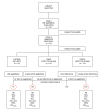Impact of continuous positive airway pressure on the pulmonary changes promoted by immersion in water
- PMID: 29340488
- PMCID: PMC5792039
- DOI: 10.1590/S1806-37562017000000088
Impact of continuous positive airway pressure on the pulmonary changes promoted by immersion in water
Abstract
Objective: To determine whether different levels of CPAP improve the lung volumes and capacities of healthy subjects immersed in water.
Methods: This was a randomized clinical trial, conducted between April and June of 2016, involving healthy female volunteers who were using oral contraceptives. Three 20-min immersion protocols were applied: control (no CPAP); CPAP5 (CPAP at 5 cmH2O); and CPAP10 (CPAP at 10 cmH2O). We evaluated HR, SpO2, FVC, FEV1, the FEV1/FVC ratio, peak expiratory flow rate (PEFR), and FEF25-75%) at three time points: pre-immersion; 10 min after immersion; and 10 min after the end of each protocol.
Results: We evaluated 13 healthy volunteers. The CPAP10 protocol reversed the restrictive pattern of lung function induced by immersion in water, maintaining pulmonary volumes and capacities for a longer period than did the CPAP5 protocol.
Conclusions: When the hemodynamic change causing a persistent lung disorder, only the application of higher positive pressures is effective in maintaining long-term improvements in the pulmonary profile.
Objetivo:: Verificar se continuous positive airway pressure (CPAP, pressão positiva contínua nas vias aéreas) em diferentes pressões melhora os volumes e capacidades pulmonares de sujeitos saudáveis em imersão em água.
Métodos:: Estudo clínico randomizado realizado entre abril e junho de 2016 com voluntárias saudáveis em uso de anticoncepcional oral. Foram aplicados três protocolos em imersão em água, todos com duração de 20 min: controle (sem aplicação de CPAP); CPAP5 (CPAP de 5 cmH2O); e CPAP10 (CPAP de 10 cmH2O). Avaliaram-se FC, SpO2, CVF, VEF1, relação VEF1/CVF em % do previsto, taxa de pico de fluxo expiratório e FEF25-75% em três momentos distintos: pré-imersão, 10 min após a imersão e 10 min após o final dos protocolos.
Resultados:: Foram avaliadas 13 voluntárias saudáveis. O protocolo CPAP10 foi capaz de reverter o padrão restritivo pulmonar induzido pela imersão em água em indivíduos saudáveis, mantendo normais os volumes e as capacidades pulmonares por um período mais prolongado quando comparado ao protocolo CPAP5.
Conclusões:: Nossos resultados indicam que, em condições cuja alteração hemodinâmica causadora do distúrbio pulmonar seja persistente, apenas a aplicação de pressões positivas mais elevadas é efetiva para manter as melhoras no quadro pulmonar por um maior tempo após a sua aplicação.
Figures



Comment in
-
Noninvasive positive airway pressure: from critically ill patients to physical exercise in outpatients.J Bras Pneumol. 2017 Nov-Dec;43(6):405-406. doi: 10.1590/S1806-37562017000060001. J Bras Pneumol. 2017. PMID: 29340485 Free PMC article. No abstract available.
Similar articles
-
[Standard technical specifications for methacholine chloride (Methacholine) bronchial challenge test (2023)].Zhonghua Jie He He Hu Xi Za Zhi. 2024 Feb 12;47(2):101-119. doi: 10.3760/cma.j.cn112147-20231019-00247. Zhonghua Jie He He Hu Xi Za Zhi. 2024. PMID: 38309959 Chinese.
-
Effects of water immersion on pulmonary function in asthmatics.Undersea Hyperb Med. 2001 Summer;28(2):75-82. Undersea Hyperb Med. 2001. PMID: 11908698
-
The effect of bi-level positive airway pressure on postoperative pulmonary function following gastric surgery for obesity.Respir Med. 2002 Sep;96(9):672-6. doi: 10.1053/rmed.2002.1357. Respir Med. 2002. PMID: 12243311 Clinical Trial.
-
The effect of continuous positive airway pressure on total cerebral blood flow in healthy awake volunteers.Sleep Breath. 2013 Mar;17(1):289-96. doi: 10.1007/s11325-012-0688-0. Epub 2012 Mar 22. Sleep Breath. 2013. PMID: 22434361 Review.
-
Pressure modification or humidification for improving usage of continuous positive airway pressure machines in adults with obstructive sleep apnoea.Cochrane Database Syst Rev. 2019 Dec 2;12(12):CD003531. doi: 10.1002/14651858.CD003531.pub4. Cochrane Database Syst Rev. 2019. PMID: 31792939 Free PMC article.
Cited by
-
Noninvasive positive airway pressure: from critically ill patients to physical exercise in outpatients.J Bras Pneumol. 2017 Nov-Dec;43(6):405-406. doi: 10.1590/S1806-37562017000060001. J Bras Pneumol. 2017. PMID: 29340485 Free PMC article. No abstract available.
References
-
- Sá NC, Banzato TC, Sasseron AB, Ferracini LC, Fregadolli P, Figueiredo LC. Análise comparativa da função respiratória de indivíduos hígidos em solo e na água. Fisioter Pesq. 2010;17(4):337–341. https://doi.org/10.1590/S1809-29502010000400010 - DOI
-
- de Andrade AD, C J, Júnior, Lins de Barros Melo TL, Rattes Lima CS, Brandão DC, de Melo Barcelar J. Influence of different levels of immersion in water on the pulmonary function and respiratory muscle pressure in healthy individuals observational study. Physiother Res Int. 2014;19(3):140–146. https://doi.org/10.1002/pri.1574 - DOI - PubMed
-
- Yamashina Y, Yokoyama H, Naghavi N, Hirasawa Y, Takeda R, Ota A. Forced respiration during the deeper water immersion causes the greater inspiratory muscle fatigue in healthy young men. J Phys Ther Sci. 2016;28(2):412–418. https://doi.org/10.1589/jpts.28.412 - DOI - PMC - PubMed
-
- Risch WD, Koubenec HJ, Beckmann U, Lange S, Gauer OH. The effect of graded immersion on heart volume, central venous pressure, pulmonary blood distribution, and heart rate in man. Pflügers Arch. 1978;374(2):115–118. https://doi.org/10.1007/BF00581289 - DOI - PubMed
-
- Johansen LB, Bie P, Warberg J, Christensen NJ, Norsk P. Role of hemodilution on renal responses to water immersion in humans. Pt 2Am J Physiol. 1995;269(5):R1068–R1076. - PubMed
Publication types
MeSH terms
Substances
LinkOut - more resources
Full Text Sources
Other Literature Sources
Miscellaneous

